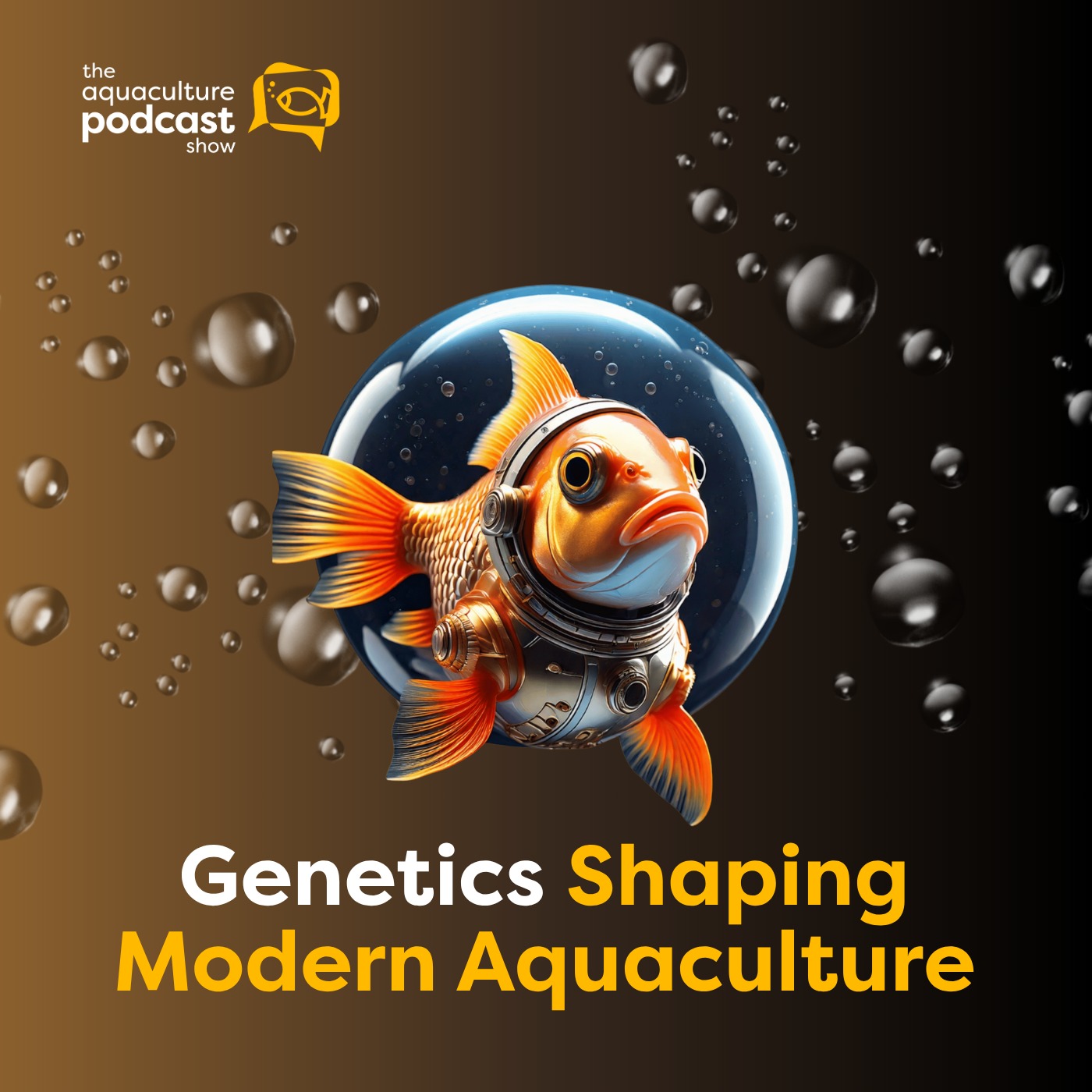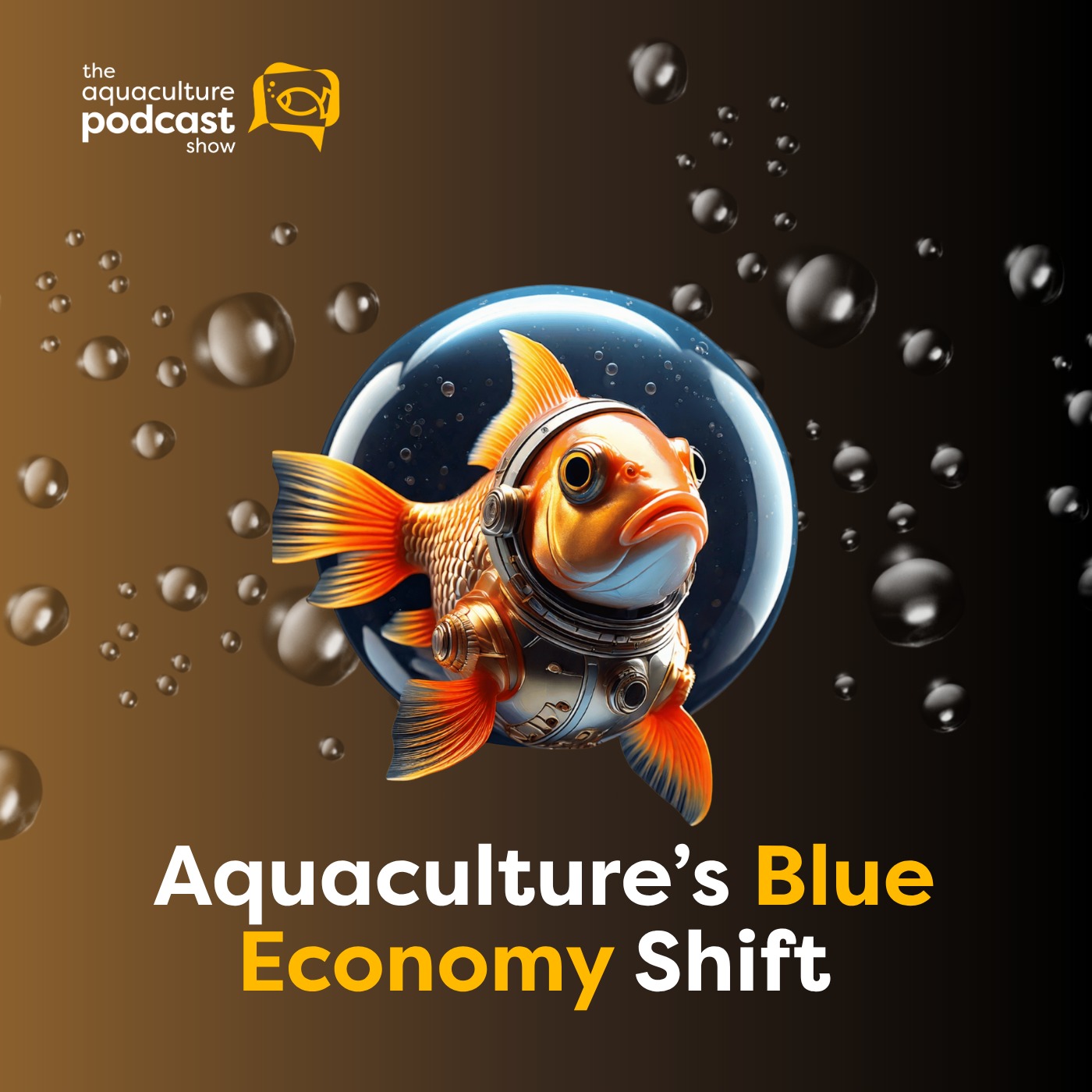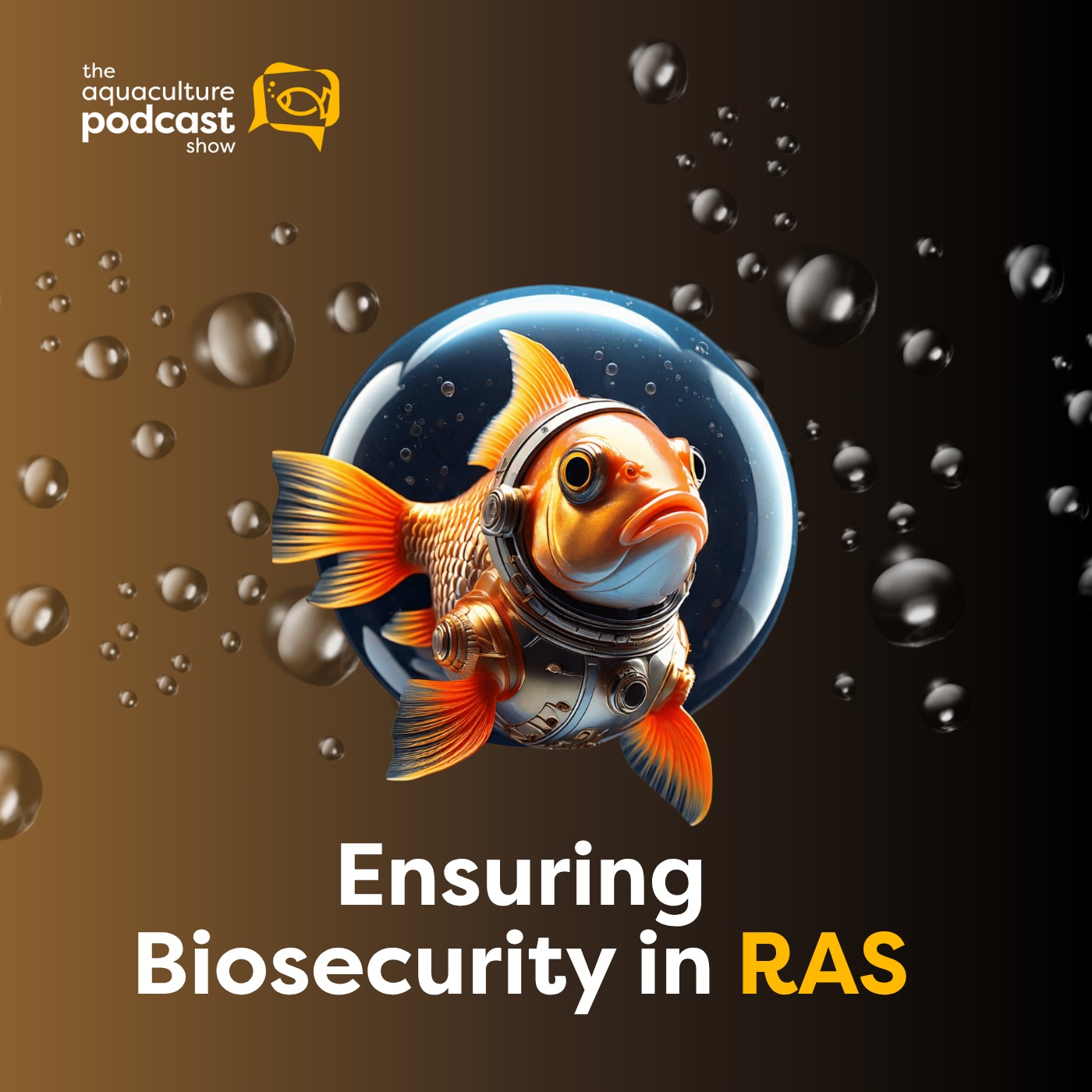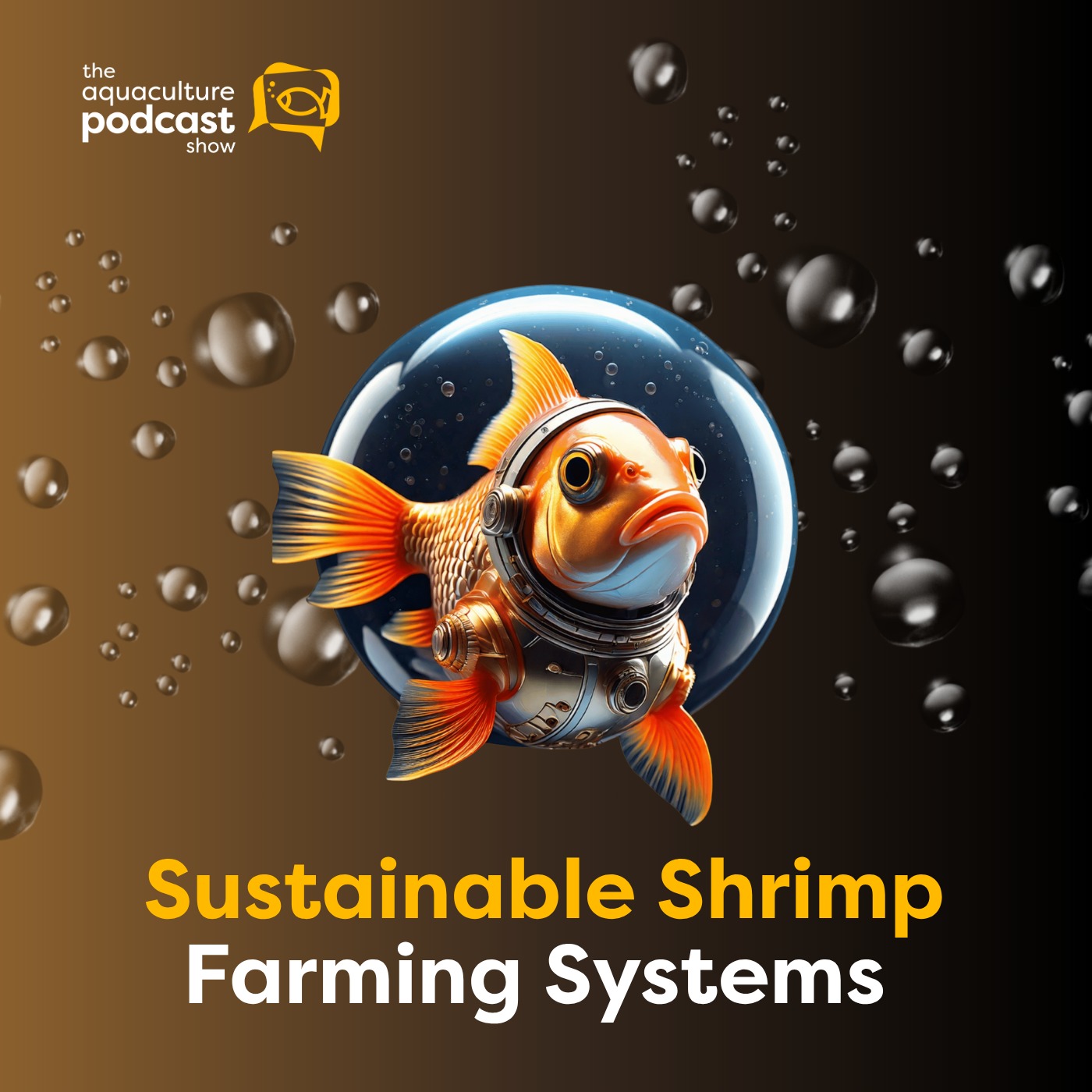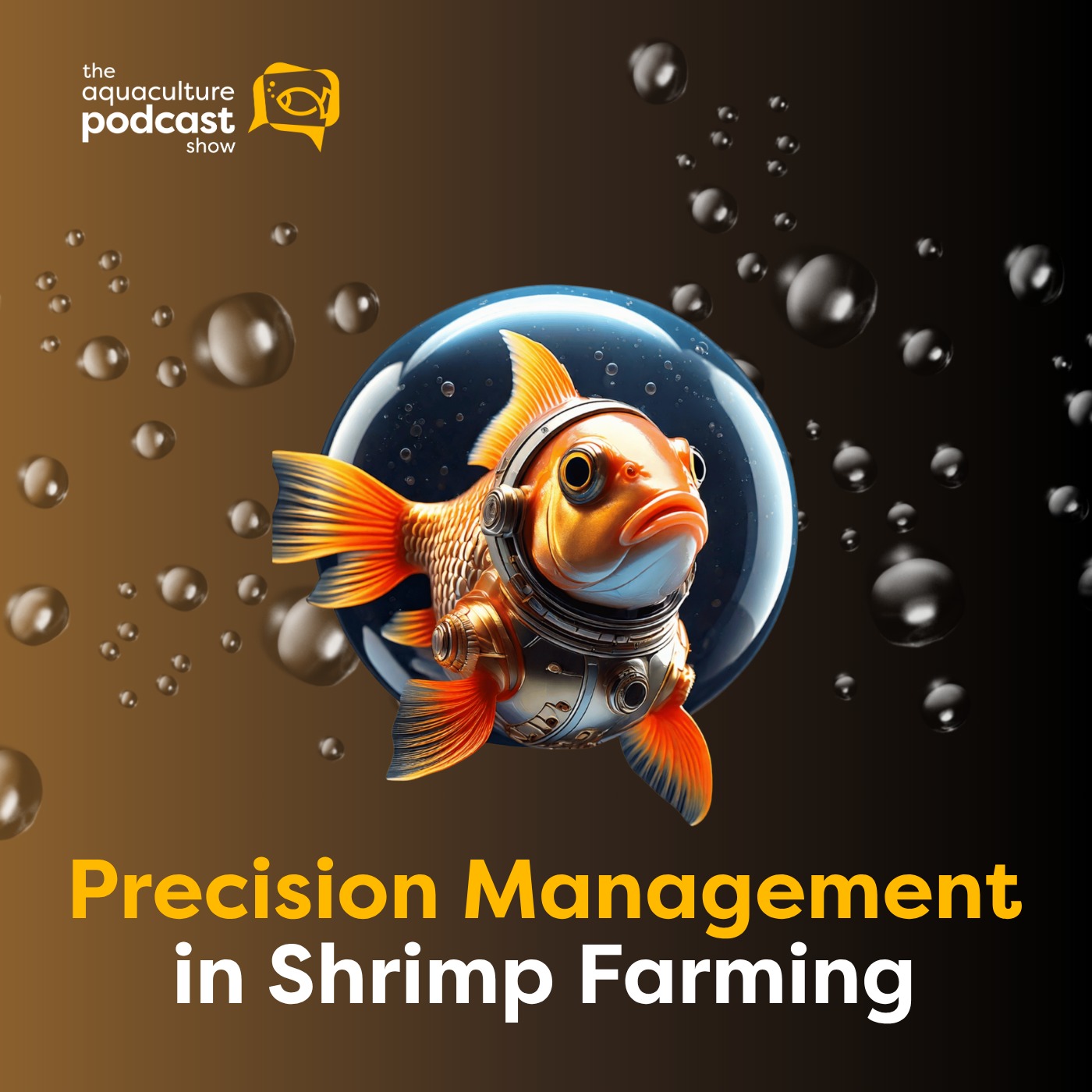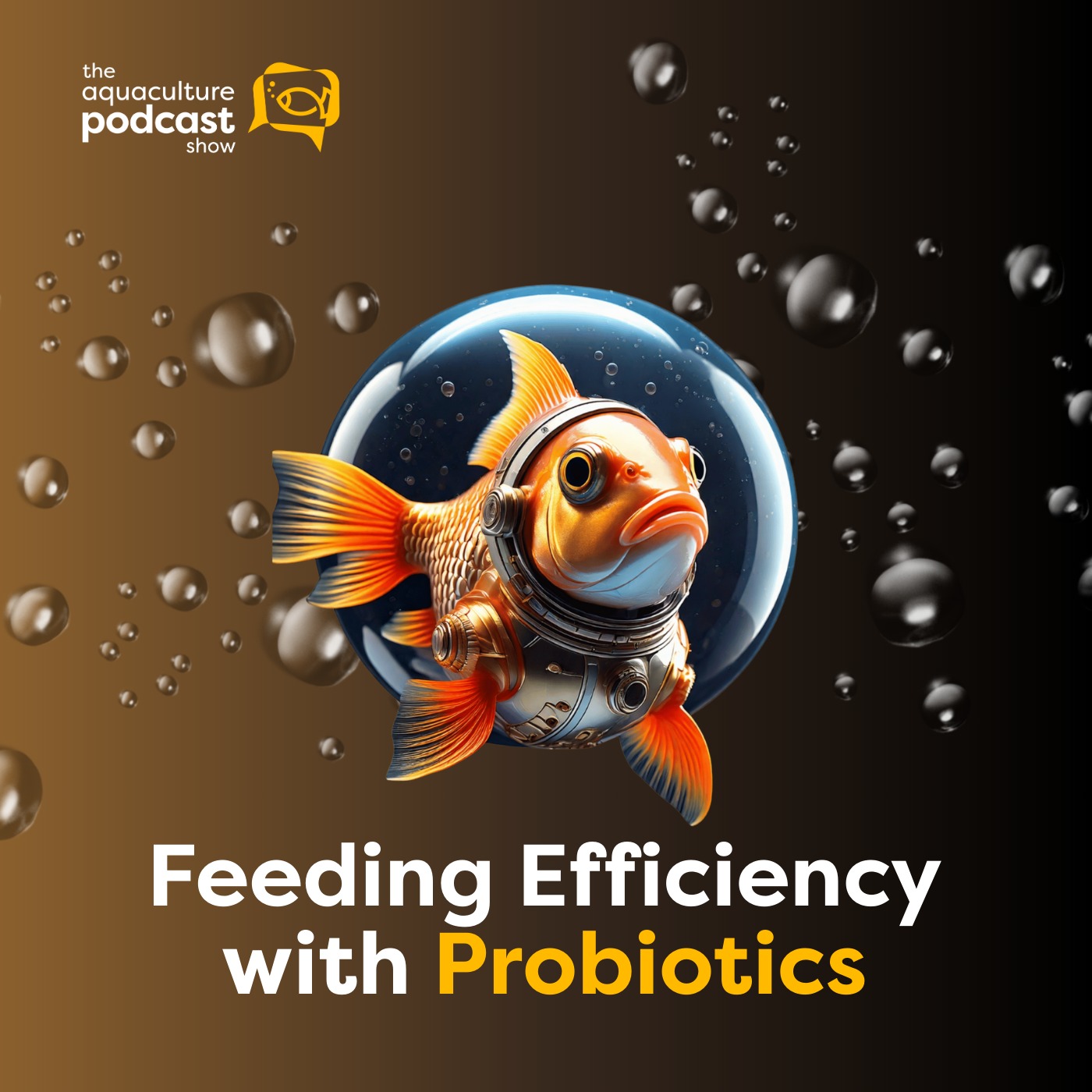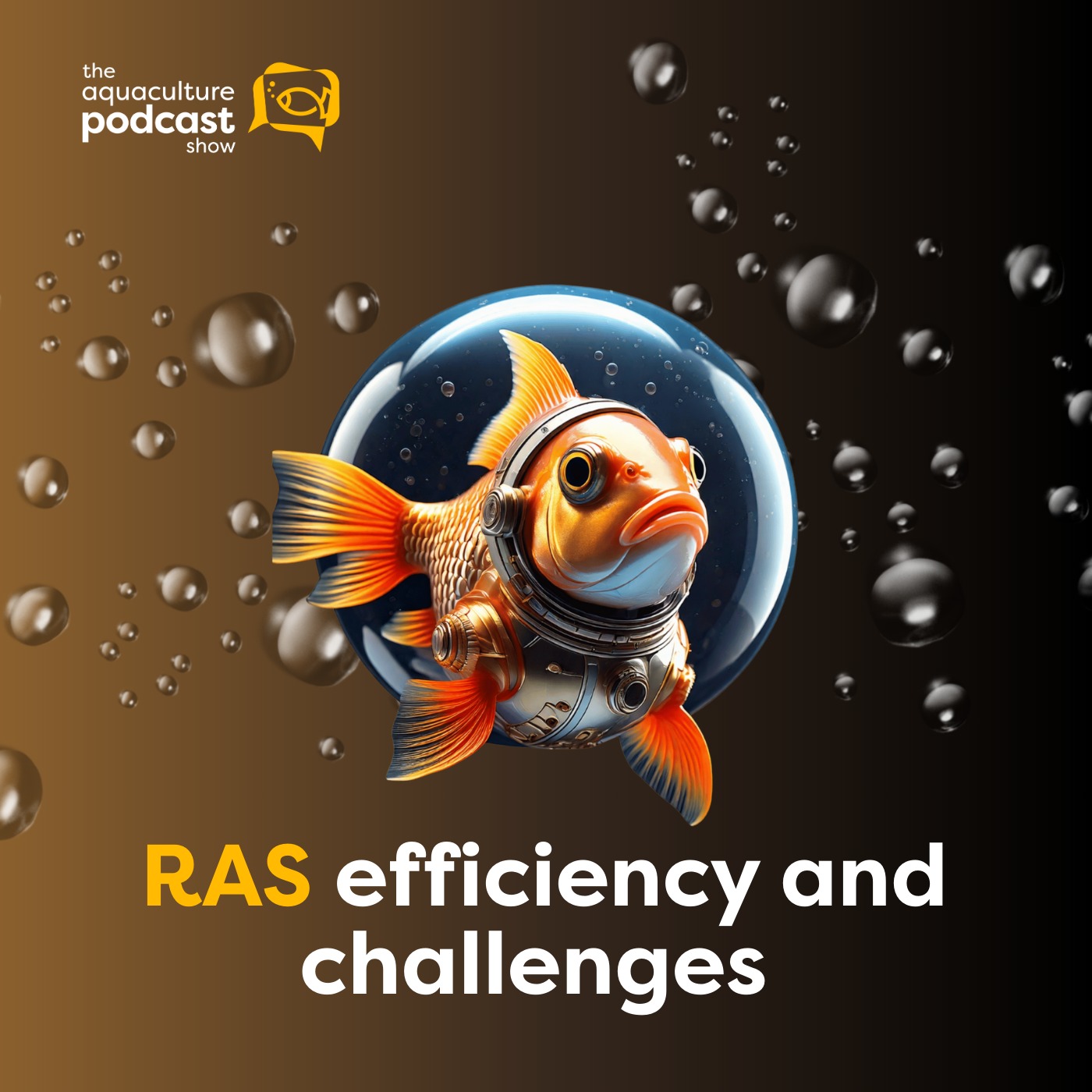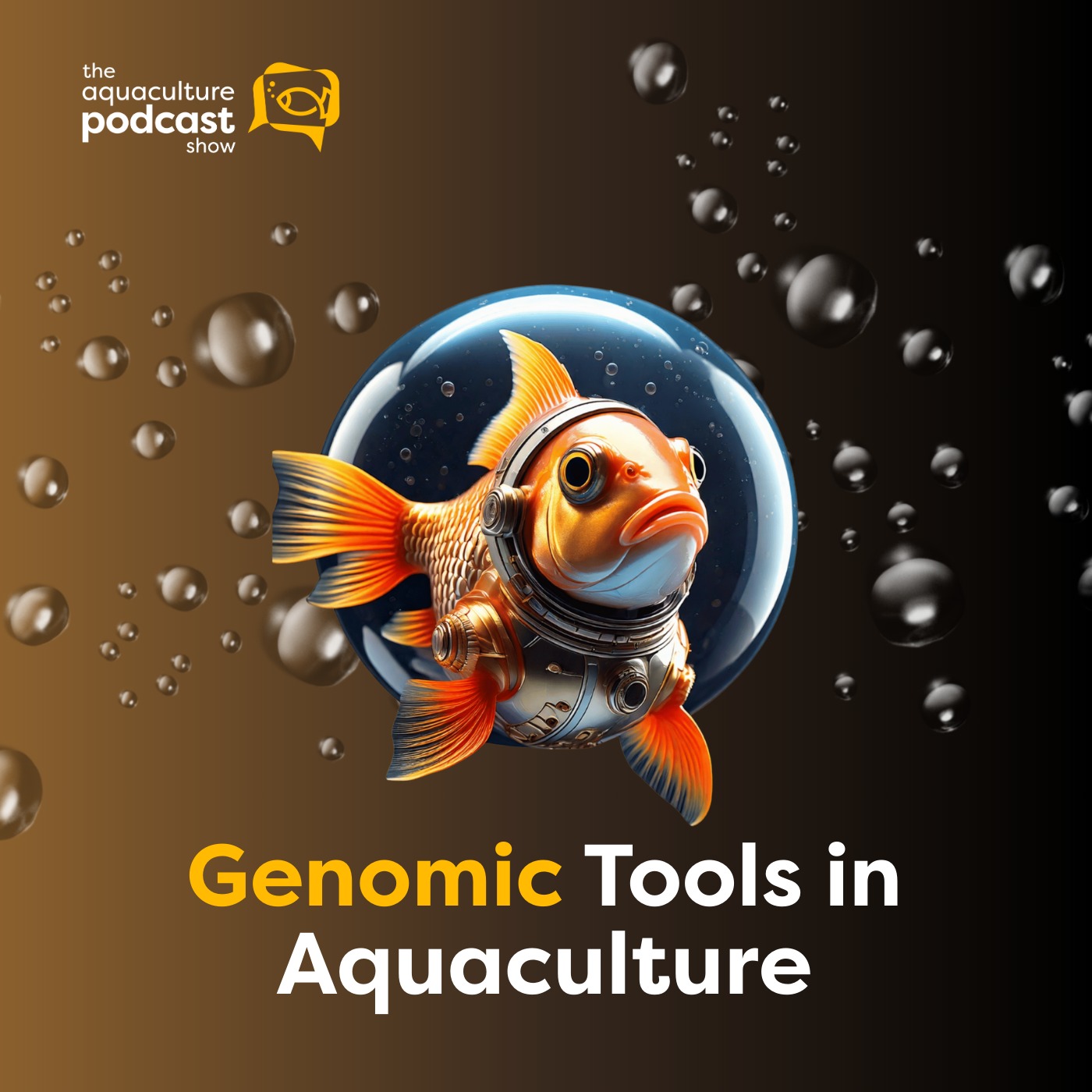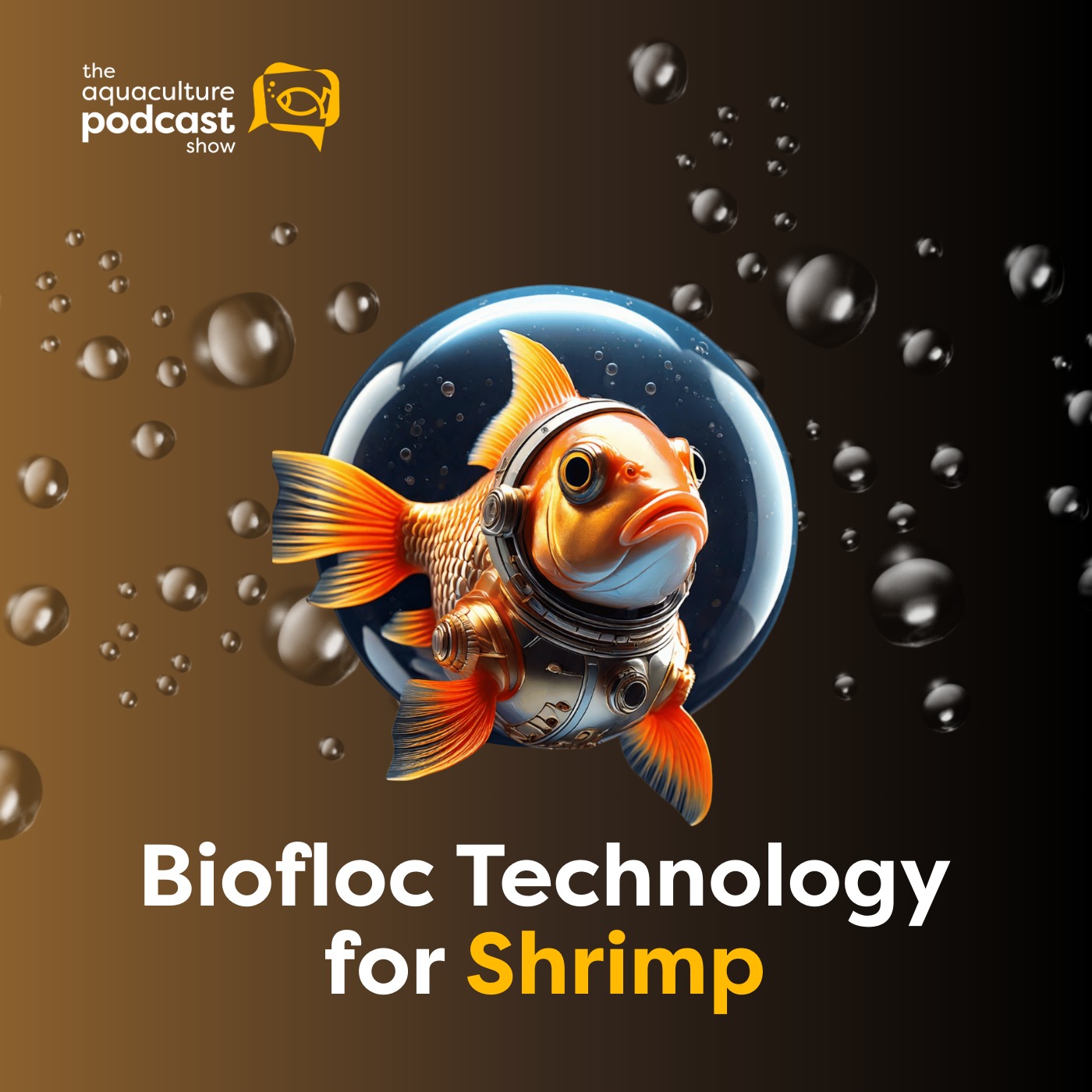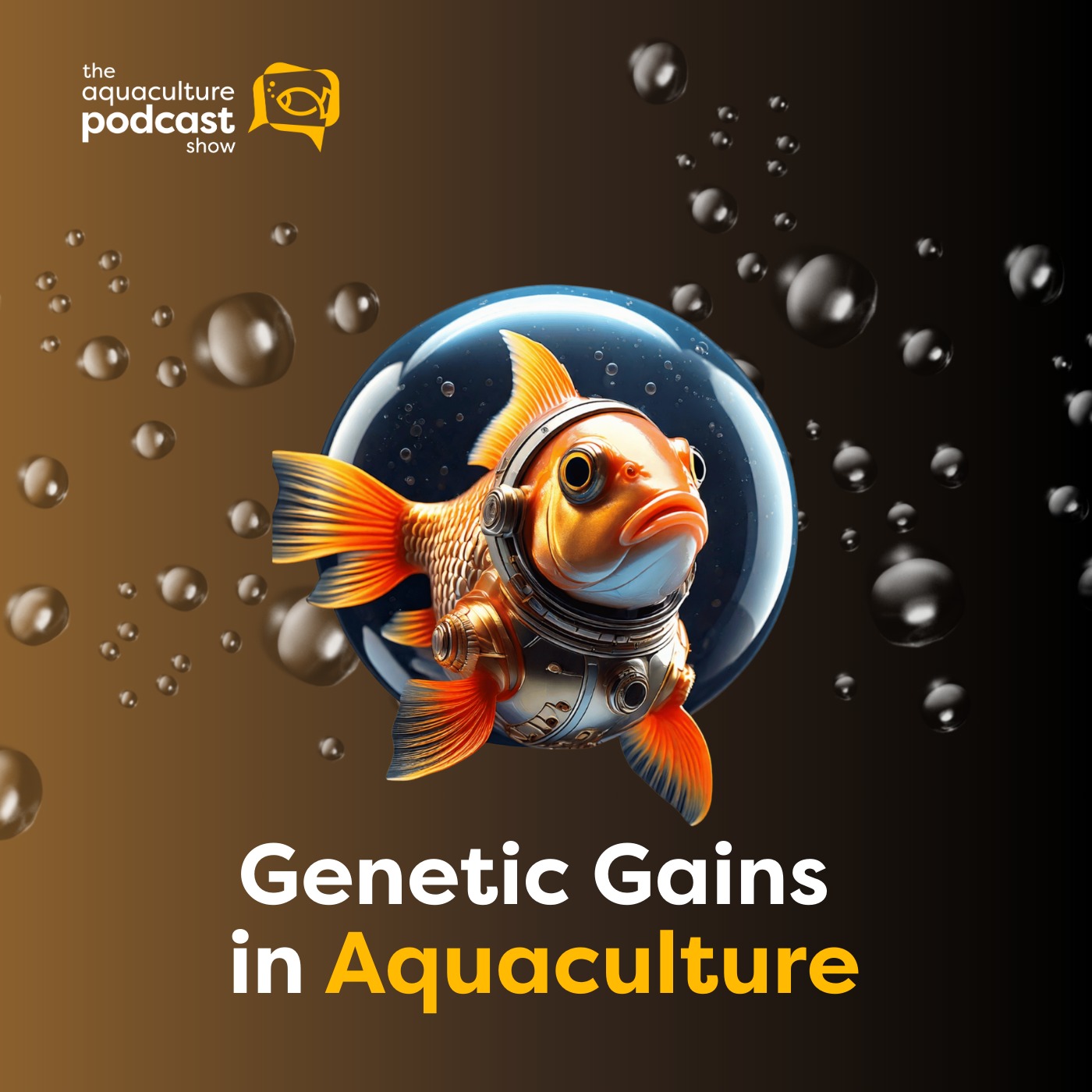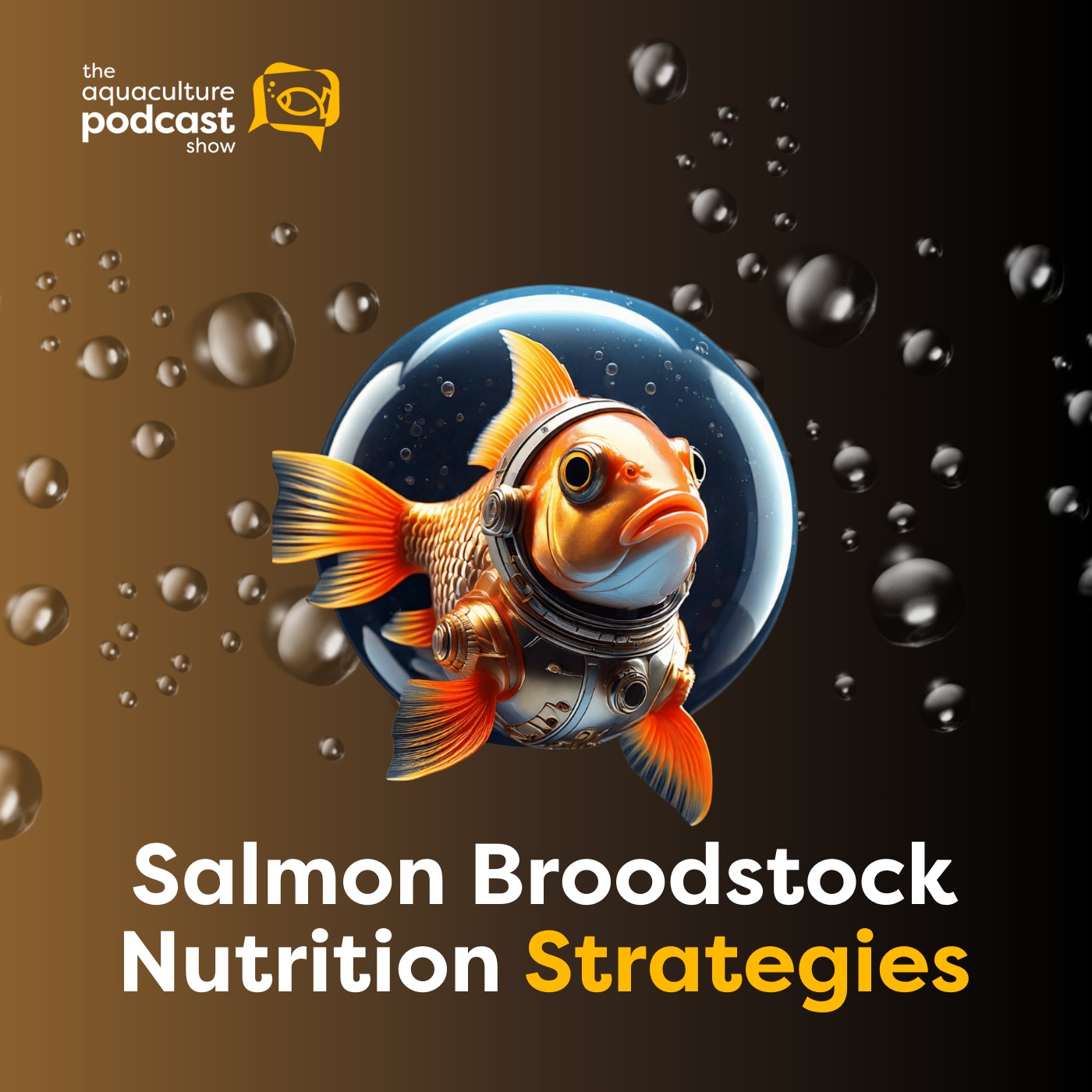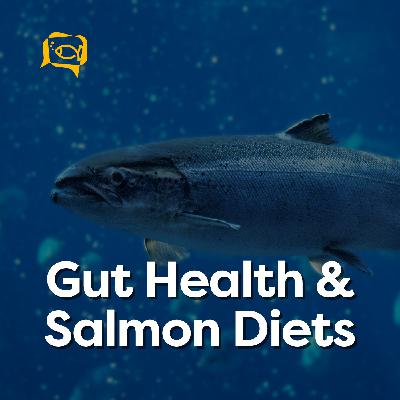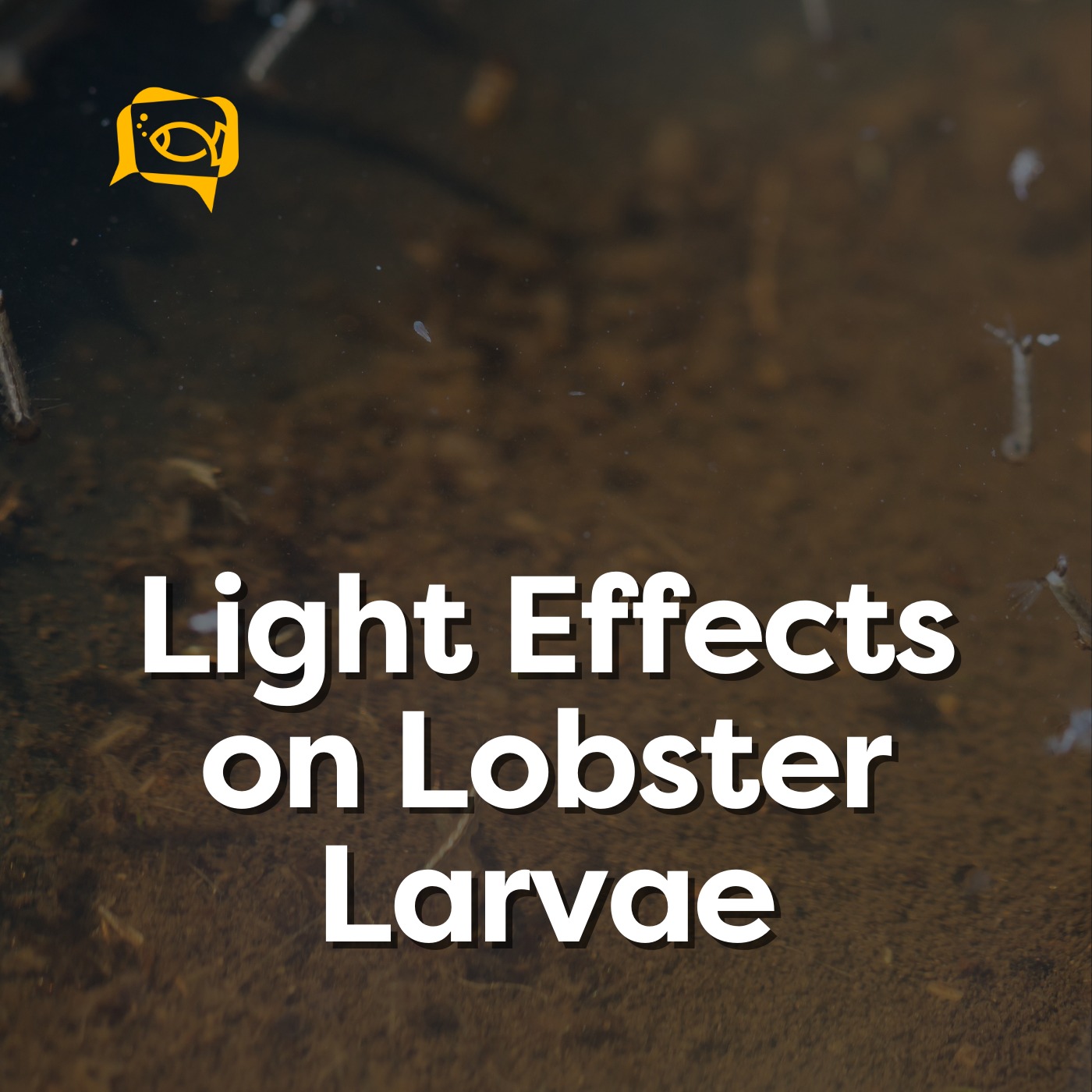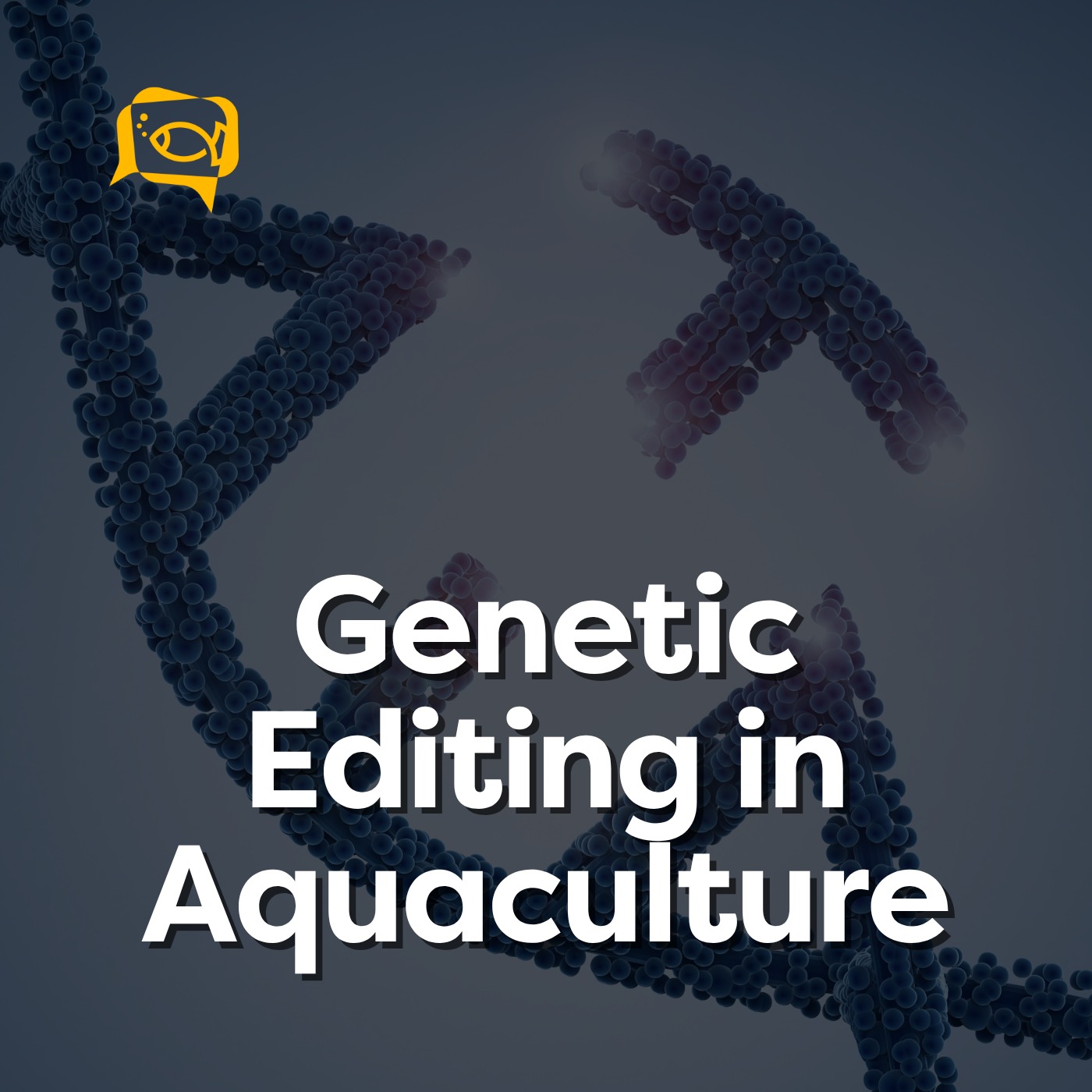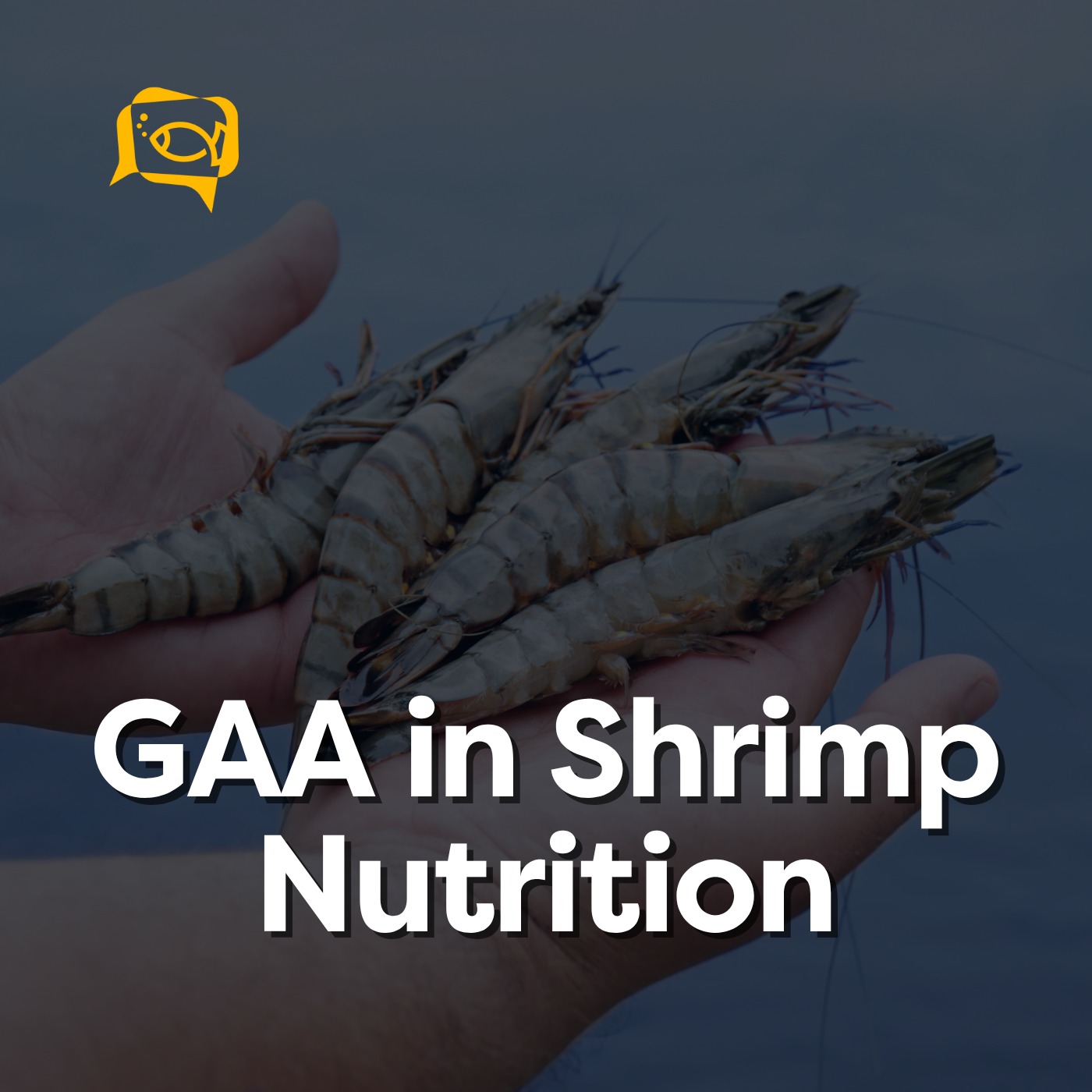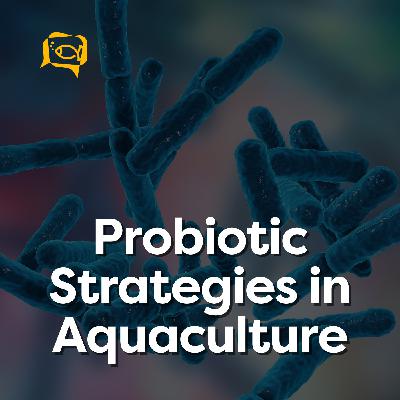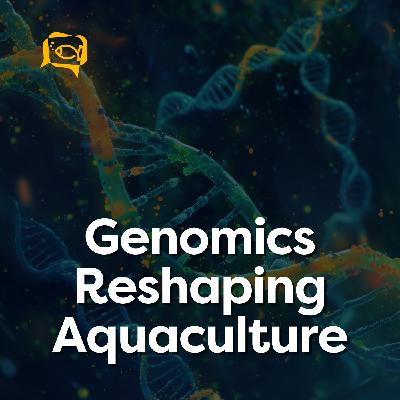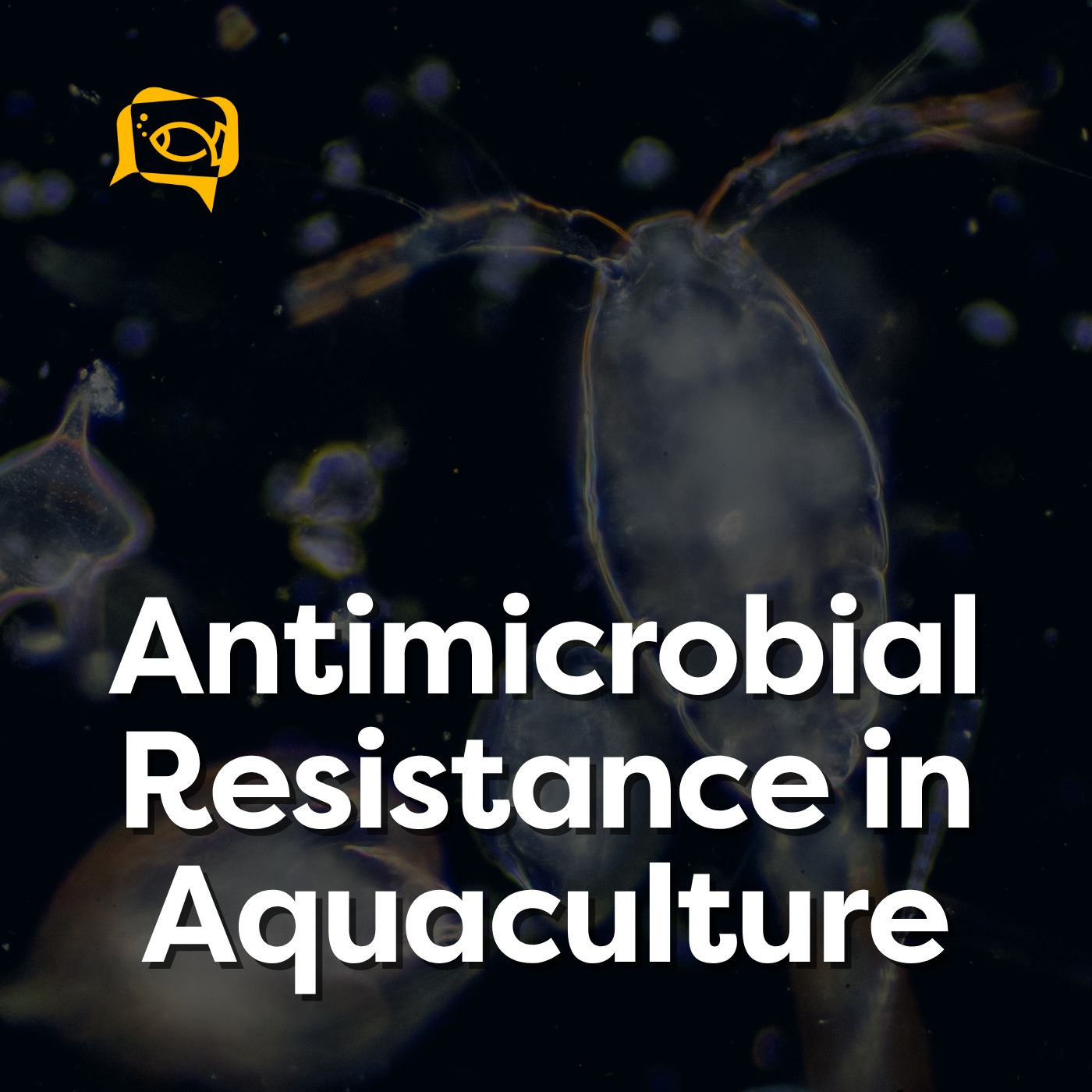Discover The Aquaculture Podcast Show • by Wisenetix
The Aquaculture Podcast Show • by Wisenetix

The Aquaculture Podcast Show • by Wisenetix
Author: Wisenetix
Subscribed: 3Played: 53Subscribe
Share
© All rights reserved.
Description
Do you want to be in the top 1% of the aquaculture industry? Then learn how to improve aquaculture production with high-impact strategies and through a modern podcast especially conceived and designed by and for the brightest minds of the global aquaculture industry.
Perfect for staying up to date with the latest research, trends and hot topics of the industry in a light and interesting way, while saving your time.
It's never been this good, and it's never been this simple.
39 Episodes
Reverse
In this episode of The Aquaculture Podcast Show, we discuss how genetic and genomic innovations are transforming modern aquaculture breeding. From closing reproduction cycles to improving feed efficiency, we cover advances in genomic selection, CRISPR editing, and multiomics integration. You will understand how these tools are shaping the future of efficient, resilient, and sustainable seafood production. Listen now on all major platforms!
Inspired by the 2022 article titled "Applications of modern genetics and genomic technologies to enhance aquaculture breeding" by Nguyen, Nguyen Hong, et al.
Read the full research article here: https://doi.org/10.3389/fgene.2022.898857
“Heritability estimates confirm that selection for disease resistance is effective and worth the investment.”
Liked this one? Don’t stop now — Here’s what we think you’ll love:
https://www.wisenetix.com/blog?tag=the+aquaculture+podcast+show
What will you learn:
(00:00) Highlight
(00:54) Introduction
(01:38) Controlled reproduction
(02:29) Genetic diversity
(06:49) Genomic selection
(07:04) Genome editing
(08:46) Multiomics approaches
(09:54) Closing thoughts
𝗟𝗶𝘀𝘁𝗲𝗻 𝗼𝗻 𝗔𝗽𝗽𝗹𝗲 𝗣𝗼𝗱𝗰𝗮𝘀𝘁𝘀, 𝗦𝗽𝗼𝘁𝗶𝗳𝘆 𝗼𝗿 𝗮𝗻𝘆 𝗺𝗮𝗷𝗼𝗿 𝗽𝗹𝗮𝘁𝗳𝗼𝗿𝗺.
Website: http://aquaculturepodcast.com/
Instagram: https://www.instagram.com/aquaculturepodcast/
LinkedIn: https://www.linkedin.com/showcase/aquaculturepodcast/about/
In this episode of The Aquaculture Podcast Show, we explore how global aquaculture production has transformed through technology, biosecurity, and sustainable intensification. From fed species and crustacean growth to seaweed’s ecological role, this reveals how innovation is reshaping the blue economy. Gain insights into biofloc, RAS systems, and precision aquaculture for a more climate-smart future. Listen now on all major platforms!
Inspired by the 2023 article titled "The contribution of aquaculture systems to global aquaculture production" by Verdegem, Marc, et al.
Read the full research article here: https://doi.org/10.1111/jwas.12963
"Biofloc technology transforms waste management by converting nitrogenous compounds into microbial biomass that becomes usable nutrition."
Liked this one? Don’t stop now — Here’s what we think you’ll love:
https://www.wisenetix.com/blog?tag=the+aquaculture+podcast+show
What will you learn:
(00:00) Highlight
(00:58) Introduction
(02:42) Crustacean risk factors
(05:32) Biofloc technology explained
(07:58) RAS system challenges
(09:46) Seaweed farming impact
(10:50) Future integration models
(11:30) Closing thoughts
𝗟𝗶𝘀𝘁𝗲𝗻 𝗼𝗻 𝗔𝗽𝗽𝗹𝗲 𝗣𝗼𝗱𝗰𝗮𝘀𝘁𝘀, 𝗦𝗽𝗼𝘁𝗶𝗳𝘆 𝗼𝗿 𝗮𝗻𝘆 𝗺𝗮𝗷𝗼𝗿 𝗽𝗹𝗮𝘁𝗳𝗼𝗿𝗺.
Website: http://aquaculturepodcast.com/
Instagram: https://www.instagram.com/aquaculturepodcast/
LinkedIn: https://www.linkedin.com/showcase/aquaculturepodcast/about/
In this episode of The Aquaculture Podcast Show, we explore how epigenetic regulation is shaping the next era of aquaculture productivity. From DNA methylation to heritable molecular memory, it reveals how environmental factors can rewrite biological instructions, impacting growth, health, and resilience in aquatic species. Discover how this science could redefine selective breeding and fish health strategies. Listen now on all major platforms!
Inspired by the 2022 article titled "Genetic and epigenetic regulation of growth, reproduction, disease resistance and stress responses in aquaculture" by Liu, Z., Zhou, T., & Gao, D.
Read the full research article here: https://doi.org/10.3389/fgene.2022.994471
“Epigenetic modification acts as a dynamic molecular switch, determining which genes respond to environmental cues through chemical tagging and methylation.”
Liked this one? Don’t stop now — Here’s what we think you’ll love:
https://www.wisenetix.com/blog?tag=the+aquaculture+podcast+show
What will you learn:
(00:00) Highlight
(00:48) Introduction
(01:48) DNA methylation
(03:48) Growth regulation
(05:43) Disease resistance
(06:23) Environmental adaptation
(07:52) Sex determination
(09:03) Closing thoughts
𝗟𝗶𝘀𝘁𝗲𝗻 𝗼𝗻 𝗔𝗽𝗽𝗹𝗲 𝗣𝗼𝗱𝗰𝗮𝘀𝘁𝘀, 𝗦𝗽𝗼𝘁𝗶𝗳𝘆 𝗼𝗿 𝗮𝗻𝘆 𝗺𝗮𝗷𝗼𝗿 𝗽𝗹𝗮𝘁𝗳𝗼𝗿𝗺.
Website: http://aquaculturepodcast.com/
Instagram: https://www.instagram.com/aquaculturepodcast/
LinkedIn: https://www.linkedin.com/showcase/aquaculturepodcast/about/
In this episode of The Aquaculture Podcast Show, we explore the design and validation of an independent RAS research facility that’s redefining salmon studies. Learn how structural independence, biosafety protocols, and biofilter variability affect research outcomes in modern aquaculture. Highlighting why statistical reliability and biosecurity are vital to RAS innovation. Listen now on all major platforms!
Inspired by the 2022 article titled "Evaluation of a recirculating aquaculture system research facility designed to address current knowledge needs in Atlantic salmon production," by Mota, Vasco C., et al.
Read the full research article here: https://doi.org/10.3389/fanim.2022.876504
“Biofilter maturation significantly affects nitrogen stability and overall system reproducibility.”
Liked this one? Don’t stop now — Here’s what we think you’ll love:
https://www.wisenetix.com/blog?tag=the+aquaculture+podcast+show
What will you learn:
(00:00) Highlight
(01:02) Introduction
(01:27) Independent system setup
(03:08) Treatment components
(04:02) Biosafety measures
(05:21) Infection trials
(06:34) Statistical validation
(09:16) Closing thoughts
𝗟𝗶𝘀𝘁𝗲𝗻 𝗼𝗻 𝗔𝗽𝗽𝗹𝗲 𝗣𝗼𝗱𝗰𝗮𝘀𝘁𝘀, 𝗦𝗽𝗼𝘁𝗶𝗳𝘆 𝗼𝗿 𝗮𝗻𝘆 𝗺𝗮𝗷𝗼𝗿 𝗽𝗹𝗮𝘁𝗳𝗼𝗿𝗺.
Website: http://aquaculturepodcast.com/
Instagram: https://www.instagram.com/aquaculturepodcast/
LinkedIn: https://www.linkedin.com/showcase/aquaculturepodcast/about/
In this episode of The Aquaculture Podcast Show, we discuss how modern shrimp farming can manage and reuse effluents to sustainably produce shrimp. The conversation explores the chemistry and biology behind nutrient waste, new engineering technologies for treatment, and the transformation of pollutants into valuable resources. Gain a clear understanding of how integration across physical, chemical, and biological systems creates real efficiency in aquaculture. Listen now on all major platforms!
Inspired by the 2021 article titled "Recent advances in shrimp aquaculture wastewater management" by Iber, B. T., and N. A. Kasan.
Read the full research article here: https://doi.org/10.1016/j.heliyon.2021.e08283
“High-rate algal ponds remove the nitrogen and phosphorus excess efficiently while transforming them into valuable algal biomass.”
Liked this one? Don’t stop now — Here’s what we think you’ll love:
https://www.wisenetix.com/blog?tag=the+aquaculture+podcast+show
What will you learn:
(00:00) Highlight
(00:57) Introduction
(01:59) Nitrogen accumulation
(04:57) Cavitation technology
(05:27) Nanofiltration systems
(06:11) Algal nutrient recycling
(07:33) Biofloc applications
(08:37) Closing thoughts
𝗟𝗶𝘀𝘁𝗲𝗻 𝗼𝗻 𝗔𝗽𝗽𝗹𝗲 𝗣𝗼𝗱𝗰𝗮𝘀𝘁𝘀, 𝗦𝗽𝗼𝘁𝗶𝗳𝘆 𝗼𝗿 𝗮𝗻𝘆 𝗺𝗮𝗷𝗼𝗿 𝗽𝗹𝗮𝘁𝗳𝗼𝗿𝗺.
Website: http://aquaculturepodcast.com/
Instagram: https://www.instagram.com/aquaculturepodcast/
LinkedIn: https://www.linkedin.com/showcase/aquaculturepodcast/about/
In this episode of The Aquaculture Podcast Show, experts discuss the latest research on intensive shrimp farming, focusing on how technology, training, and adaptive management reduce disease risks in Litopenaeus vannamei systems. The conversation explores how data-driven strategies, water quality management, and predictive tools are reshaping sustainable aquaculture under climate challenges. Learn what drives resilience in shrimp production, listen now on all major platforms!
Inspired by the 2024 article titled "Climatic events and disease occurrence in intensive Litopenaeus vannamei shrimp farming in the Mekong area of Vietnam" by Le, Ngan Thi Thanh, et al.
Read the full research article here: https://doi.org/10.1016/j.aquaculture.2024.740867
“High stocking density, when supported by advanced technology, can actually lower disease probability.”
Liked this one? Don’t stop now — Here’s what we think you’ll love:
https://www.wisenetix.com/blog?tag=the+aquaculture+podcast+show
What will you learn:
(00:00) Highlight
(01:11) Introduction
(01:45) Climate risk management
(03:09) Feeding precision
(04:11) Stocking density
(05:24) Farm longevity
(07:26) Heat stress management
(08:13) Closing thoughts
𝗟𝗶𝘀𝘁𝗲𝗻 𝗼𝗻 𝗔𝗽𝗽𝗹𝗲 𝗣𝗼𝗱𝗰𝗮𝘀𝘁𝘀, 𝗦𝗽𝗼𝘁𝗶𝗳𝘆 𝗼𝗿 𝗮𝗻𝘆 𝗺𝗮𝗷𝗼𝗿 𝗽𝗹𝗮𝘁𝗳𝗼𝗿𝗺.
Website: http://aquaculturepodcast.com/
Instagram: https://www.instagram.com/aquaculturepodcast/
LinkedIn: https://www.linkedin.com/showcase/aquaculturepodcast/about/
In this episode of The Aquaculture Podcast Show, we explore how beneficial microorganisms are changing the future of freshwater aquaculture. They can improve feed conversion, boost fish immunity, cut nutrient discharge, and keep water quality in check. We talk about the real opportunities and challenges of using probiotics in large-scale systems, share key research findings, and look ahead to what’s needed for sustainable growth. Tune in now on your favorite podcast platform.
Inspired by the 2021 article titled "Probiotics have the potential to significantly mitigate the environmental impact of freshwater fish farms" by Nathanailides, Cosmas, et al.
Read the full research article here: https://doi.org/10.3390/fishes6040076
"Beneficial microorganisms improve nutrient digestibility by producing enzymes that fish cannot naturally produce in sufficient amounts."
Liked this one? Don’t stop now — Here’s what we think you’ll love:
https://www.wisenetix.com/blog?tag=the+aquaculture+podcast+show
What will you learn:
(00:00) Highlight
(01:02) Introduction
(02:06) Feed efficiency
(03:32) Fish immunity
(04:57) Water quality
(05:52) Disease resistance
(06:12) Sustainability data
(07:13) Closing thoughts
𝗟𝗶𝘀𝘁𝗲𝗻 𝗼𝗻 𝗔𝗽𝗽𝗹𝗲 𝗣𝗼𝗱𝗰𝗮𝘀𝘁𝘀, 𝗦𝗽𝗼𝘁𝗶𝗳𝘆 𝗼𝗿 𝗮𝗻𝘆 𝗺𝗮𝗷𝗼𝗿 𝗽𝗹𝗮𝘁𝗳𝗼𝗿𝗺.
Website: http://aquaculturepodcast.com/
Instagram: https://www.instagram.com/aquaculturepodcast/
LinkedIn: https://www.linkedin.com/showcase/aquaculturepodcast/about/
In this episode of The Aquaculture Podcast Show, we look at how genetic technologies are changing the way fish and shrimp farmers manage disease. From breeding stocks that are naturally more resistant to balancing growth with resilience, we explore how selective breeding and genomic tools are shaping a more sustainable future. Discover the latest strategies for healthier aquaculture populations and fewer losses. Tune in now on your favorite platform!
Inspired by the 2023 article titled "Applying genetic technologies to combat infectious diseases in aquaculture" by Robinson, Nicholas A., et al.
Read the full research article here: https://doi.org/10.1111/raq.12733
"Selective breeding for resistance is not theoretical. It is entirely feasible, supported by heritability values showing clear genetic components in aquaculture species."
Liked this one? Don’t stop now — Here’s what we think you’ll love:
https://www.wisenetix.com/blog?tag=the+aquaculture+podcast+show
What will you learn:
(00:00) Highlight
(01:03) Introduction
(01:21) Genetic resistance
(02:55) Selective breeding
(03:47) Trade-offs in growth
(06:15) Genomic tools
(08:28) Future challenges
(09:35) Closing thoughts
𝗟𝗶𝘀𝘁𝗲𝗻 𝗼𝗻 𝗔𝗽𝗽𝗹𝗲 𝗣𝗼𝗱𝗰𝗮𝘀𝘁𝘀, 𝗦𝗽𝗼𝘁𝗶𝗳𝘆 𝗼𝗿 𝗮𝗻𝘆 𝗺𝗮𝗷𝗼𝗿 𝗽𝗹𝗮𝘁𝗳𝗼𝗿𝗺.
Website: http://aquaculturepodcast.com/
Instagram: https://www.instagram.com/aquaculturepodcast/
LinkedIn: https://www.linkedin.com/showcase/aquaculturepodcast/about/
In this episode of The Aquaculture Podcast Show, we’re talking about land-based recirculating aquaculture systems (RAS) for Atlantic salmon. We look at how these systems boost biosecurity, offer better control over the environment, and bring production closer to key markets. But we also explore the challenges, from energy demands and saltwater issues to technical, biological, and economic hurdles. You'll hear about the latest genetic advancements shaping the future of salmon farming. Want to stay on top of aquaculture innovation? Tune in now, available on all major platforms.
Inspired by the 2024 article titled "Assessing the benefits and challenges of recirculating aquaculture systems (RAS) for Atlantic Salmon production" by Brown, A. Ross, Rod W. Wilson, and Charles R. Tyler.
Read the full research article here: https://doi.org/10.1080/23308249.2024.2433581
"Water reuse rates in recirculating systems can exceed 98%, enabling precise control over environmental conditions and significantly improving fish health outcomes."
Liked this one? Don’t stop now — Here’s what we think you’ll love:
https://www.wisenetix.com/blog?tag=the+aquaculture+podcast+show
What will you learn:
(00:00) Highlight
(01:17) Introduction
(01:59) RAS efficiency
(02:37) Lifecycle management
(03:57) Water monitoring
(05:09) Biosecurity risks
(06:14) Energy challenges
(08:09) Closing thoughts
𝗟𝗶𝘀𝘁𝗲𝗻 𝗼𝗻 𝗔𝗽𝗽𝗹𝗲 𝗣𝗼𝗱𝗰𝗮𝘀𝘁𝘀, 𝗦𝗽𝗼𝘁𝗶𝗳𝘆 𝗼𝗿 𝗮𝗻𝘆 𝗺𝗮𝗷𝗼𝗿 𝗽𝗹𝗮𝘁𝗳𝗼𝗿𝗺.
Website: http://aquaculturepodcast.com/
Instagram: https://www.instagram.com/aquaculturepodcast/
LinkedIn: https://www.linkedin.com/showcase/aquaculturepodcast/about/
In this episode of The Aquaculture Podcast Show, we explore how genomic tools are reshaping the future of fish and seafood production. From lowering barriers to genetic analysis with the Aquaculture Molecular Breeding Platform (AMBP) to balancing rapid gains with long-term sustainability, highlighting critical strategies for growth. Learn how these technologies can improve disease resistance, resilience, and productivity in aquaculture. Listen now on all major platforms!
Inspired by the 2022 article titled "Aquaculture Molecular Breeding Platform (AMBP): a comprehensive web server for genotype imputation and genetic analysis in aquaculture" by Zeng, Qifan, et al.
Read the full research article here:
https://doi.org/10.1093/nar/gkac424
"Genomic selection accelerates short-term gains, but unchecked use risks eroding genetic diversity and increasing inbreeding over generations."
Liked this one? Don’t stop now — Here’s what we think you’ll love:
https://www.wisenetix.com/blog?tag=the+aquaculture+podcast+show
What will you learn:
(00:00) Highlight
(00:58) Introduction
(01:58) Rising seafood demand
(03:07) Genomic technologies
(04:44) Imputation benefits
(06:01) Genetic diversity
(07:17) Breeding strategies
(10:24) Closing thoughts
𝗟𝗶𝘀𝘁𝗲𝗻 𝗼𝗻 𝗔𝗽𝗽𝗹𝗲 𝗣𝗼𝗱𝗰𝗮𝘀𝘁𝘀, 𝗦𝗽𝗼𝘁𝗶𝗳𝘆 𝗼𝗿 𝗮𝗻𝘆 𝗺𝗮𝗷𝗼𝗿 𝗽𝗹𝗮𝘁𝗳𝗼𝗿𝗺.
Website: http://aquaculturepodcast.com/
Instagram: https://www.instagram.com/aquaculturepodcast/
LinkedIn: https://www.linkedin.com/showcase/aquaculturepodcast/about/
In this episode of The Aquaculture Podcast Show, we explore how biofloc technology is reshaping shrimp farming through microbial nutrient recycling, water reuse, and improved feed efficiency. This system offers practical solutions to long-standing production challenges. Learn about performance benchmarks, essential management practices, and cutting-edge innovations driving adoption. Listen now on all major platforms.
Inspired by the 2025 article titled "Application of Biofloc technology in shrimp aquaculture: A review on current practices, challenges, and future perspectives" by Iber, Benedict Terkula, et al.
Read the full research article here:
https://doi.org/10.1016/j.jafr.2025.101675
"Heterotrophic bacteria take up nitrogen compounds, like ammonia, directly from the water and convert them into microbial protein."
Liked this one? Don’t stop now — Here’s what we think you’ll love:
https://www.wisenetix.com/blog?tag=the+aquaculture+podcast+show
What will you learn:
(00:00) Highlight
(01:17) Introduction
(01:35) Biofloc system basics
(02:22) Microbial nutrient recycling
(03:34) Shrimp health benefits
(04:35) Performance benchmarks
(05:44) Operational challenges
(08:18) Closing thoughts
𝗟𝗶𝘀𝘁𝗲𝗻 𝗼𝗻 𝗔𝗽𝗽𝗹𝗲 𝗣𝗼𝗱𝗰𝗮𝘀𝘁𝘀, 𝗦𝗽𝗼𝘁𝗶𝗳𝘆 𝗼𝗿 𝗮𝗻𝘆 𝗺𝗮𝗷𝗼𝗿 𝗽𝗹𝗮𝘁𝗳𝗼𝗿𝗺.
Website: http://aquaculturepodcast.com/
Instagram: https://www.instagram.com/aquaculturepodcast/
LinkedIn: https://www.linkedin.com/showcase/aquaculturepodcast/about/
In this episode of The Aquaculture Podcast Show, we explore the untapped genetic potential within global aquaculture and how it could transform fish and shellfish production. We discuss the current challenges in conservation, genetic erosion, and the underutilization of selective breeding. Learn how advanced tools, smarter policies, and international frameworks can shape a more resilient industry. Listen now on all major platforms!
Inspired by the 2023 article titled "Sustainable management and improvement of genetic resources for aquaculture" by Sonesson, A., et al.
Read the full research article here:
https://doi.org/10.1111/jwas.12968
"Strategic management of aquatic genetic resources is essential for achieving long-term productivity, resilience, and sustainability in modern aquaculture."
Liked this one? Don’t stop now — Here’s what we think you’ll love:
https://www.wisenetix.com/blog?tag=the+aquaculture+podcast+show
What will you learn:
(00:00) Highlight
(01:12) Introduction
(01:53) Genetic resource management
(02:48) Selective breeding impact
(04:25) Conservation of wild relatives
(05:56) Introduced species risks
(07:14) Global breeding strategies
(10:22) Closing thoughts
𝗟𝗶𝘀𝘁𝗲𝗻 𝗼𝗻 𝗔𝗽𝗽𝗹𝗲 𝗣𝗼𝗱𝗰𝗮𝘀𝘁𝘀, 𝗦𝗽𝗼𝘁𝗶𝗳𝘆 𝗼𝗿 𝗮𝗻𝘆 𝗺𝗮𝗷𝗼𝗿 𝗽𝗹𝗮𝘁𝗳𝗼𝗿𝗺.
Website: http://aquaculturepodcast.com/
Instagram: https://www.instagram.com/aquaculturepodcast/
LinkedIn: https://www.linkedin.com/showcase/aquaculturepodcast/about/
In this episode of The Aquaculture Podcast Show, we unpack how shifting spawning seasons in Atlantic salmon impacts both broodstock and their offspring. We also explore how metabolic stress, nutrient allocation, and biochemical pathways influence egg quality and larval growth. Get insights into nutritional programming and its role in sustainable aquaculture productivity. Learn how broodstock nutrition strategies can optimize year-round production. Listen now on all major platforms!
Inspired by the 2022 article titled "Earlier or delayed seasonal broodstock spawning changes nutritional status and metabolic programming of growth for next-generation Atlantic salmon" by Skjærven, K., et al.
Read the full research article here:
https://doi.org/10.1016/j.aquaculture.2022.738187
"Phase-specific feeding strategies are required to mitigate muscle breakdown in broodstock undergoing prolonged fasting."
Liked this one? Don’t stop now — Here’s what we think you’ll love:
https://www.wisenetix.com/blog?tag=the+aquaculture+podcast+show
What will you learn:
(00:00) Highlight
(00:48) Introduction
(01:20) Spawning timing
(02:56) Maternal metabolism
(04:18) Nutrient programming
(05:10) Egg composition
(07:01) Larval growth
(08:51) Closing thoughts
𝗟𝗶𝘀𝘁𝗲𝗻 𝗼𝗻 𝗔𝗽𝗽𝗹𝗲 𝗣𝗼𝗱𝗰𝗮𝘀𝘁𝘀, 𝗦𝗽𝗼𝘁𝗶𝗳𝘆 𝗼𝗿 𝗮𝗻𝘆 𝗺𝗮𝗷𝗼𝗿 𝗽𝗹𝗮𝘁𝗳𝗼𝗿𝗺.
Website: http://aquaculturepodcast.com/
Instagram: https://www.instagram.com/aquaculturepodcast/
LinkedIn: https://www.linkedin.com/showcase/aquaculturepodcast/about/
In this episode of The Aquaculture Podcast Show, we explore how yeast-based additives can help reduce gut inflammation caused by high soybean meal diets in juvenile Atlantic salmon. Learn how beta-glucan and yeast extracts impact tissue recovery, immune modulation, and gene expression. Find out what the data says about dosing and long-term performance. Listen now on all major platforms!
Inspired by the 2025 article titled "Brewers’ Yeast (Saccharomyces cerevisiae) Purified Functional Feed Additives Mitigate Soybean Meal‐Induced Enteritis in Atlantic Salmon (Salmo salar) Parr" by Momoh, T. A., et al.
Read the full research article here:
https://doi.org/10.1155/anu/8555658
"Beta-glucan and yeast extract reduced inflammation, immune cell infiltration, and mucus overproduction, maintaining gut integrity in salmon."
Liked this one? Don’t stop now — Here’s what we think you’ll love:
https://www.wisenetix.com/blog?tag=the+aquaculture+podcast+show
What will you learn:
(00:00) Highlight
(01:01) Introduction
(01:59) Yeast-based feed additives
(03:11) Gut tissue histology
(04:22) Gene expression findings
(05:45) Systemic immune response
(06:51) Growth performance data
(08:08) Closing thoughts
𝗟𝗶𝘀𝘁𝗲𝗻 𝗼𝗻 𝗔𝗽𝗽𝗹𝗲 𝗣𝗼𝗱𝗰𝗮𝘀𝘁𝘀, 𝗦𝗽𝗼𝘁𝗶𝗳𝘆 𝗼𝗿 𝗮𝗻𝘆 𝗺𝗮𝗷𝗼𝗿 𝗽𝗹𝗮𝘁𝗳𝗼𝗿𝗺.
Website: http://aquaculturepodcast.com/
Instagram: https://www.instagram.com/aquaculturepodcast/
LinkedIn: https://www.linkedin.com/showcase/aquaculturepodcast/about/
In this episode of The Aquaculture Podcast Show, we explore a groundbreaking breakthrough in cultivating the European spiny lobster. By optimizing light intensity and pairing it with high-quality nutrition, researchers achieved a survival rate increase from under 1% to over 40%. This could redefine commercial viability and sustainability in lobster aquaculture. Listen now on all major platforms!
Inspired by the 2024 article titled "Effect of light intensity on the survival of European spiny lobster (Palinurus elephas) larvae reared in aquaculture system" by Filippi, J. J., et al.
Read the full research article here:
https://doi.org/10.1016/j.aqrep.2024.102083
"Exposure to medium and high light intensities led to an unprecedented increase in larval survival, surpassing forty percent."
Liked this one? Don’t stop now — Here’s what we think you’ll love:
https://www.wisenetix.com/blog?tag=the+aquaculture+podcast+show
What will you learn:
(00:00) Highlight
(00:52) Introduction
(00:42) Larval survival challenges
(01:21) Light intensity tested
(02:13) Results and survival rates
(03:59) Feeding behavior
(04:58) Nutrition synergy
(06:19) Closing thoughts
𝗟𝗶𝘀𝘁𝗲𝗻 𝗼𝗻 𝗔𝗽𝗽𝗹𝗲 𝗣𝗼𝗱𝗰𝗮𝘀𝘁𝘀, 𝗦𝗽𝗼𝘁𝗶𝗳𝘆 𝗼𝗿 𝗮𝗻𝘆 𝗺𝗮𝗷𝗼𝗿 𝗽𝗹𝗮𝘁𝗳𝗼𝗿𝗺.
Website: http://aquaculturepodcast.com/
Instagram: https://www.instagram.com/aquaculturepodcast/
LinkedIn: https://www.linkedin.com/showcase/aquaculturepodcast/about/
In this episode of The Aquaculture Podcast Show, learn how advanced genetic tools are reshaping aquaculture production, nutrition, and sustainability. We explore real-world examples like disease-resistant fish, sterile breeding lines, and nutrient-enhanced traits. Discover the risks, opportunities, and responsible deployment strategies shaping the future of aquatic protein. Listen now on all major platforms!
Inspired by the 2024 article titled "A guide to assess the use of gene editing in aquaculture" by Robinson, N. A., et al.
Read the full research article here:
https://doi.org/10.1111/raq.12866
"Advanced genetic tools allow highly specific genome edits that target both problematic traits and desirable enhancements with remarkable accuracy."
Liked this one? Don’t stop now — Here’s what we think you’ll love:
https://www.wisenetix.com/blog?tag=the+aquaculture+podcast+show
What will you learn:
(00:00) Highlight
(00:59) Introduction
(01:01) Genetic editing benefits
(01:56) Disease resistance examples
(02:06) Sterile fish applications
(04:06) Environmental risk management
(05:15) Assessment frameworks explained
(06:21) Closing thoughts
𝗟𝗶𝘀𝘁𝗲𝗻 𝗼𝗻 𝗔𝗽𝗽𝗹𝗲 𝗣𝗼𝗱𝗰𝗮𝘀𝘁𝘀, 𝗦𝗽𝗼𝘁𝗶𝗳𝘆 𝗼𝗿 𝗮𝗻𝘆 𝗺𝗮𝗷𝗼𝗿 𝗽𝗹𝗮𝘁𝗳𝗼𝗿𝗺.
Website: http://aquaculturepodcast.com/
Instagram: https://www.instagram.com/aquaculturepodcast/
LinkedIn: https://www.linkedin.com/showcase/aquaculturepodcast/about/
In this episode of The Aquaculture Podcast Show, we explore how guanidinoacetic acid (GAA) supplementation can improve growth, immunity, and stress resistance in intensive white shrimp farming. We also breaks down GAA’s effect on feed efficiency, antioxidant activity, and survival rates under disease pressure. Learn how a small additive can support better yields and system resilience.
Inspired by the 2025 article titled "Guanidinoacetic Acid Significantly Improves Growth, Antioxidant Capacity, and Nonspecific Immunity for Juvenile Litopenaeus vannamei" by Lin, H., et al.
Read the full research article here:
https://doi.org/10.1155/anu/5538869
"Adding guanidinoacetic acid at levels of 0.10% to 0.13% significantly improved white shrimp weight gain and growth rates."
Liked this one? Don’t stop now — Here’s what we think you’ll love:
https://www.wisenetix.com/blog?tag=the+aquaculture+podcast+show
What will you learn:
(00:00) Highlight
(01:01) Introduction
(00:45) GAA and shrimp growth
(01:43) Feed conversion results
(02:24) Oxidative stress response
(03:24) Immune enzyme activation
(04:26) Vibrio challenge results
(05:04) Closing thoughts
𝗟𝗶𝘀𝘁𝗲𝗻 𝗼𝗻 𝗔𝗽𝗽𝗹𝗲 𝗣𝗼𝗱𝗰𝗮𝘀𝘁𝘀, 𝗦𝗽𝗼𝘁𝗶𝗳𝘆 𝗼𝗿 𝗮𝗻𝘆 𝗺𝗮𝗷𝗼𝗿 𝗽𝗹𝗮𝘁𝗳𝗼𝗿𝗺.
Website: http://aquaculturepodcast.com/
Instagram: https://www.instagram.com/aquaculturepodcast/
LinkedIn: https://www.linkedin.com/showcase/aquaculturepodcast/about/
In this episode of The Aquaculture Podcast Show, we explore how probiotics are reshaping fish and shrimp farming practices. We also explain how specific strains impact immunity, feed efficiency, and water quality, while also addressing risks like antibiotic resistance. Learn what makes these microbial tools effective and what must be done to ensure safe, consistent results. Listen now on all major platforms!
Inspired by the 2024 article titled "Probiotics for aquaculture: Hope, truth, and reality." Probiotics and Antimicrobial Proteins" by Todorov, S. D., et al.
Read the full research article here:
https://doi.org/10.1007/s12602-024-10290-8
“Integrating microbial solutions is becoming central to sustainable, efficient, and environmentally responsible fish and seafood farming.”
Liked this one? Don’t stop now — Here’s what we think you’ll love:
https://www.wisenetix.com/blog?tag=the+aquaculture+podcast+show
What will you learn:
(00:00) Highlight
(00:57) Introduction
(01:11) Microbial strain selection
(02:17) Probiotic health benefits
(03:27) Environmental compatibility
(04:32) Delivery method impact
(04:57) Risk management strategies
(08:03) Closing thoughts
𝗟𝗶𝘀𝘁𝗲𝗻 𝗼𝗻 𝗔𝗽𝗽𝗹𝗲 𝗣𝗼𝗱𝗰𝗮𝘀𝘁𝘀, 𝗦𝗽𝗼𝘁𝗶𝗳𝘆 𝗼𝗿 𝗮𝗻𝘆 𝗺𝗮𝗷𝗼𝗿 𝗽𝗹𝗮𝘁𝗳𝗼𝗿𝗺.
Website: http://aquaculturepodcast.com/
Instagram: https://www.instagram.com/aquaculturepodcast/
LinkedIn: https://www.linkedin.com/showcase/aquaculturepodcast/about/
In this episode of The Aquaculture Podcast Show, a new genomic breeding success story emerges from New Zealand’s snapper aquaculture program. We discuss how selective breeding, hatchery management, and genetic tools boosted growth, survival, and consistency across generations. Learn how this approach could reshape climate-resilient fish farming. Listen now on all major platforms!
Inspired by the 2024 article titled "Generational breeding gains in a new species for aquaculture, the Australasian snapper (Chrysophrys auratus)" by Samuels, G., et al.
Read the full research article here:
https://doi.org/10.1016/j.aquaculture.2024.740782
"Selective breeding across four snapper generations led to a 60 percent weight increase by six months of age."
Liked this one? Don’t stop now — Here’s what we think you’ll love:
https://www.wisenetix.com/blog?tag=the+aquaculture+podcast+show
What will you learn:
(00:00) Highlight
(00:58) Introduction
(01:42) Selective breeding gains
(02:41) Hatchery innovations
(04:08) Genetic management
(05:59) Climate adaptation potential
(06:55) Commercial scale results
(08:32) Closing thoughts
𝗟𝗶𝘀𝘁𝗲𝗻 𝗼𝗻 𝗔𝗽𝗽𝗹𝗲 𝗣𝗼𝗱𝗰𝗮𝘀𝘁𝘀, 𝗦𝗽𝗼𝘁𝗶𝗳𝘆 𝗼𝗿 𝗮𝗻𝘆 𝗺𝗮𝗷𝗼𝗿 𝗽𝗹𝗮𝘁𝗳𝗼𝗿𝗺.
Website: http://aquaculturepodcast.com/
Instagram: https://www.instagram.com/aquaculturepodcast/
LinkedIn: https://www.linkedin.com/showcase/aquaculturepodcast/about/
In this episode of The Aquaculture Podcast Show, we explore the growing threat of antimicrobial resistance (AMR) in aquaculture and its wide-reaching implications. Key points include the environmental impact of antimicrobial misuse, the mechanisms of resistance spread, and sustainable alternatives like probiotics and vaccines. Learn how responsible practices can mitigate AMR and support global seafood health. Listen now on all major platforms!Inspired by the 2024 article titled "Antimicrobial Resistance in Aquaculture: Risk Mitigation within the One Health Context" by Milijasevic, M., et al.Click here to read the full research article!“Strong surveillance and consistent monitoring are essential to guide antimicrobial use and hold the industry accountable.”Liked this one? Don’t stop now — Here’s what we think you’ll love!What will you learn: (00:00) Highlight(00:52) Introduction(01:50) One health framework(03:39) Environmental contamination(05:23) Resistance spread mechanics(08:10) Resistance detection methods(09:42) Antibiotic alternatives(12:59) Closing thoughts𝗟𝗶𝘀𝘁𝗲𝗻 𝗼𝗻 𝗔𝗽𝗽𝗹𝗲 𝗣𝗼𝗱𝗰𝗮𝘀𝘁𝘀, 𝗦𝗽𝗼𝘁𝗶𝗳𝘆 𝗼𝗿 𝗮𝗻𝘆 𝗺𝗮𝗷𝗼𝗿 𝗽𝗹𝗮𝘁𝗳𝗼𝗿𝗺.Website: The Aquaculture Podcast ShowInstagram: The Aquaculture Podcast ShowLinkedIn: The Aquaculture Podcast Show


